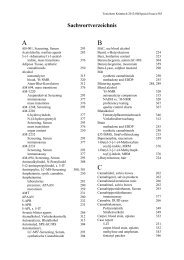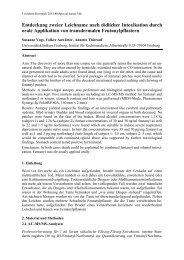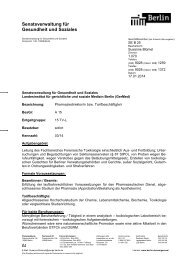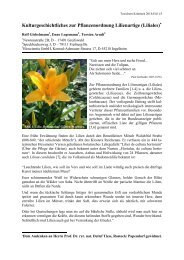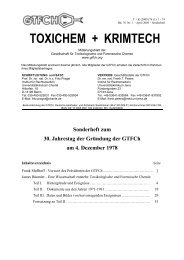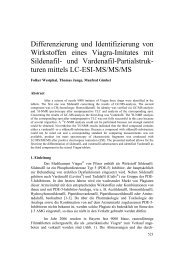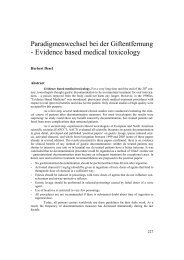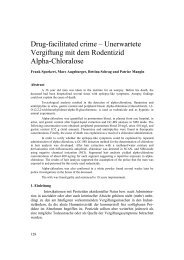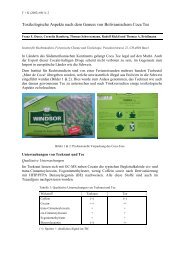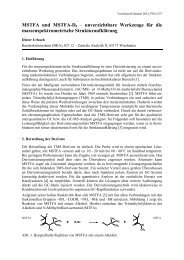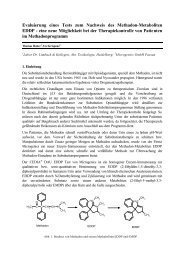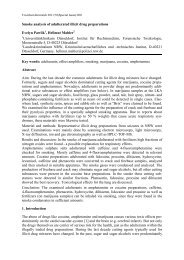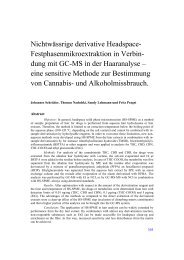Poisoning with unknown substance, “Munchhausen by ... - GTFCh
Poisoning with unknown substance, “Munchhausen by ... - GTFCh
Poisoning with unknown substance, “Munchhausen by ... - GTFCh
Create successful ePaper yourself
Turn your PDF publications into a flip-book with our unique Google optimized e-Paper software.
Toxichem Krimtech 2013;80(1):38<br />
<strong>Poisoning</strong> <strong>with</strong> <strong>unknown</strong> <strong>substance</strong>, <strong>“Munchhausen</strong> <strong>by</strong> proxy”?<br />
André Scholer, Cedric Wernli, Désirée Krebs, Geneviève Faffa, Dominic Grienenberger<br />
Laboratory Medicine, Clinical Chemistry Laboratory, Toxicology Team University Hospital<br />
Basel, Spitalstrasse 21, CH 4031 Basel, Switzerland<br />
Summary<br />
An almost 3-year-old boy is admitted to the emergency department in a pediatric hospital.<br />
According to his mother, he had vomited blood during the night. During his admission, he became<br />
comatose and had to be intubated. After 24 hours he became conscious again and was in<br />
relatively stable medical condition. The qualitative urine analysis showed the presence of Baclofen.<br />
After a two-week admission, the boy was ready to be released back home. Suspicion<br />
of poisoning from either the mother or the father was also a concern (similar to a Munchhausen<br />
<strong>by</strong> proxy case). After several weeks, the mother admitted to having given the boy the<br />
Baclofen herself. Four years after hospital admission, the legal aftermath has decided to declare<br />
the case as heavy personal injury and not as an attempt to kill. Because the case has<br />
some parallels to a <strong>“Munchhausen</strong> <strong>by</strong> proxy” syndrome, and this problem is not well known,<br />
even under toxicologists, the following introduction illustrates this.<br />
1. Introduction. <strong>“Munchhausen</strong> <strong>by</strong> proxy”<br />
In 1977, the English pediatrician Roy Meadow published two cases in which mothers had secretly<br />
made their children ill [1]. He had made the discovery himself after difficult investigation.<br />
In one of the cases, the mother secretly added blood and pus to the child’s urine and this<br />
for the duration of six years during which time the child had to endure endless medical examinations.<br />
The child was in fact completely healthy. In the second case, a 6-week old infant<br />
boy was admitted to the hospital for vomiting and clouding of consciousness. This happened<br />
several times, and each time increased sodium values (hypernatremia) was found in the blood.<br />
During each hospital stay, the child always recovered well, appeared healthy and thrived<br />
normally.<br />
A year later after several of these incidences, the doctors recognized a pattern as these<br />
incidences never occurred while the boy was in the hospital. While separated from his mother<br />
the boy recovered fully. After an error in reasoning made <strong>by</strong> the doctors, the boy was handed<br />
back to the mother on psychosocial grounds, after which he was re-admitted to hospital in a<br />
comatose state and subsequently died. The mother, who was a nurse, had administered the<br />
salt to the boy through a stomach tube. Meadow named the clinical picture <strong>“Munchhausen</strong> <strong>by</strong><br />
Proxy”, Munchhausen being the term synonymous <strong>with</strong> the ‘made-up’ stories told <strong>by</strong> the<br />
Baron of Munchhausen, and <strong>by</strong>-proxy because it is not done to one’s own body but to<br />
someone else’s.<br />
2. Emergency Admission, Case History<br />
On a Monday morning at 10:50 a.m., an almost 3-year-old boy was brought in <strong>by</strong> his mother<br />
to the emergency department of a children’s hospital. She was desperate and stated that the<br />
boy, completely healthy, had suddenly thrown up fresh blood three times around 7:30 a.m.<br />
She could not say exactly how much blood. The boy had then become increasingly calm and<br />
even apathetic, which is why she decided to take him to the emergency department. The boy
Toxichem Krimtech 2013;80(1):39<br />
was an otherwise healthy child and did not have any reported infections, coughs or diarrhea<br />
during the previous weeks. Accidental intoxication from cleaning agents, medication or other<br />
household toxins had not been observed <strong>by</strong> the mother. According to the mother the boy had<br />
been at his father’s the previous day; the father and mother are separated, and the father lives<br />
<strong>with</strong> his parents. As a result of a car accident, the father suffers from paraplegia and has been<br />
treated <strong>with</strong> various drugs. He lives alone and manages his live <strong>by</strong> himself. The parents of the<br />
mother’s new friend (now her husband) and the father see the child regularly at weekends.<br />
The most important medication was:<br />
Baclofen (Lioresal): muscle relaxant, spasms of the muscular system from spinal<br />
marrow disease, spinal cord injury or MS, inflammation and other medical conditions<br />
Gabapentin (Neurontin): anticonvulsant, indication as concomitant treatment of partial<br />
cramps (adults), pain relief of post-herpetic neuralgia<br />
Tolterodine (Detrusitol): specific muscarinic receptor antagonist, anticholinergic drug:<br />
is mainly used to treat urinary incontinence<br />
3. Development, examinations after hospital admittance<br />
Upon admittance, the boy was in good general health; a blood sample was taken to be certain.<br />
The medically relevant laboratory analyses were unobtrusive except for a slightly raised<br />
thrombin time (24 sec reference values 13-22) and a weak acidosis two hours after admittance.<br />
Fluid was administered (NaCl 0.9%) as a precaution. The laboratory parameters tested referred<br />
to the kidneys, liver, heart, respiratory function, acid-bases and electrolyte balance,<br />
clotting and glucose. Further examinations such as CT etc. were normal.<br />
During his stay in the emergency department, the boy became noticeably apathetic and fell<br />
asleep. The vital parameters are monitored during this time. Two hours after admittance the<br />
boy vomited several times, <strong>with</strong>out blood, while asleep. Within a short space of time he became<br />
comatose <strong>with</strong> a GCS of 4-6. He was transferred to the intensive care unit as his condition<br />
became critical (EEG showed highly pathological findings). During this period, a urine<br />
sample was taken for toxicological testing. It took 24 hours before the boy could be extubated<br />
and was able to breathe spontaneously again. Days later he was transferred to the general<br />
ward. He was released after 14 days.<br />
4. Toxicological Analysis<br />
Upon admission, the screening via immunoassays for common drugs in urine was negative.<br />
Just three days after admission and as a result of several interviews <strong>with</strong> the mother (during<br />
which it should be pointed out that she frequently referred to her ex-husband’s medication and<br />
there<strong>by</strong> causing direct suspicion in his way), the possibility of a medication intoxication could<br />
not be ruled out leading to the order the boy’s blood the first day of admission to be re-tested<br />
(this was, however, no longer available in the hospital). Medications that could have been the<br />
potential culprit were Baclofen, Gabapentin, Amitriptyline, Tolterodine.<br />
Amitriptyline was ruled out from the start since the TCA analysis was negative. Regarding<br />
the other medications, a rapid validation for new parameters had to be carried out prior to<br />
analysis as a supplement to the existing “general target screening” <strong>with</strong> LCMSMS via reference<br />
material from medicine (hospital pharmacy).<br />
Urine from the day of admittance was still available which was forwarded to us after consultation<br />
<strong>with</strong> the patient’s general practitioner.
Toxichem Krimtech 2013;80(1):40<br />
During the conversation, she mentioned that this case might need to be brought to court (for<br />
the case of whoever turned out to be the guilty party, to include the possibility not being ruled<br />
out of the child having taken medication that was lying around).<br />
The physician was informed that retroactively only a qualitative LC-MSMS urine analysis<br />
was possible. The results were: Gabapentin, Amitriptyline, Tolterodine negative, Baclofen<br />
positive. No other <strong>substance</strong>s found.<br />
Fig. 1. LC-MSMS of the<br />
internal standard (benzoylecgonine;<br />
above) and baclofen<br />
after library search at RT 6.83<br />
(below).<br />
Weeks later, we were informed <strong>by</strong> the Institute of legal medicine Basel that a blood sample<br />
was received at a later date that was put aside as a reserve on the day of admittance to hospital<br />
as a precaution. In this sample, Baclofen was the only <strong>substance</strong> confirmed to be present<br />
(serum concentration 3.8 mg/L).<br />
Tab. 1. Pharmacological parameters and metabolism see [2].<br />
Parameter Baclofen Gabapentine Tolterodine<br />
Proteinbinding (Fraction) 0.3 1.1 > 85 ?<br />
Baclofen Side Effects Toxicity [2]<br />
Nausea, sedation, dry mouth, dizziness, headache, low blood pressure, general weakness,<br />
tremor, sleeplessness<br />
Withdrawal symptoms after long-term use: hallucinations, agitation, psychoses,<br />
hypertension, fever, cramps<br />
Overdosing: Confusion, dizziness, sleepiness, heart-palpitations, paralyses, hypothermia,<br />
bradycardia, seizures, respiratory paralysis, coma
Toxichem Krimtech 2013;80(1):41<br />
Gabapentin Side Effects Toxicity [2]<br />
<br />
<br />
<br />
Sleepiness, ataxia, dizziness, fatigue, nystagmus<br />
Other symptoms, especially after long-term use: heart-palpitations; high and low<br />
blood pressure; inflammation of the gums, oral mucous membranes, the gastrointestinal<br />
tract, tendons, inside the nose or throat; hair loss; etc.<br />
Overdosing: Confusion, sleepiness, unintelligible speech, lethargy, diarrhea, heartpalpitations,<br />
paralyses, hypothermia, low blood pressure, respiratory paralysis, coma<br />
Tolterodine Side Effects Toxicity [2]<br />
<br />
<br />
<br />
Headache, dry mouth, constipation, dizziness, sleepiness, visual impairment<br />
Overdosing: confusion, respiratory insufficiency, tachycardia, urine retention<br />
Diagnosis: Baclofen intoxication in a comatose state, artificial respiration, suspected<br />
poisoning <strong>by</strong> the mother<br />
5. Discharge summary<br />
The discharge summary was: 2-year-, 10-month-old boy in good general health. ENT, cardiac,<br />
abdominal, lymph nodes, neurology: unobtrusive, healthy. Diagnosis: Baclofen intoxication<br />
in a comatose state, artificial respiration, suspected poisoning <strong>by</strong> the mother<br />
The boy was discharged after 14 days. After many psychological assessments conducted in<br />
the hospital <strong>with</strong> all members of the family, the boy was temporarily being cared for <strong>by</strong> the<br />
paternal grandmother after agreement of the corresponding civil court. During the ensuing<br />
weeks, further meetings took place, and after checking the cause of an earlier hospital stay<br />
(three months prior to the current incident), the mother admitted to having given the boy the<br />
Baclofen herself.<br />
History of the first incident: The mother brought the boy to the emergency department as he<br />
was showing unusual behaviour. She informed the attending ED physician that the boy drank<br />
Red Bull and swallowed a pill. Except for mydriasis, the boy did not show any other worrying<br />
symptoms and was discharged after a short stay. The urine screening for toxicological <strong>substance</strong>s<br />
was negative except for a high amount of caffeine which was identified via HPLC on<br />
Remedi from the company BioRad. After the above-mentioned discussions <strong>with</strong> the attending<br />
physician and the suspected case of <strong>“Munchhausen</strong> <strong>by</strong> proxy”, we were asked to test any remaining<br />
urine that might still be available for further <strong>substance</strong>s. The toxicological follow-up<br />
test via LCMS from this urine sample three months later identified: Ritalinic acid detectable<br />
(metabolite of the methylphenidate).<br />
6. Judicial Aftermath<br />
According to newspaper Information [4,5] the court has decided in the following manner: The<br />
mother is guilty for heavy personal injury, failer to rend assistance in a emergency situation,<br />
false charge (father), but verdict of not guilty for attempt to kill. The verdict was made out<br />
partially suspended sentence of 3 years, 1 year of the three custodial sentence, 2 years suspended<br />
sentence after a probation period. The child continues to live <strong>with</strong> the mother. She had<br />
committed during a difficult time in her life (divorce, acrimony <strong>with</strong> the ex-husband, uncertainty<br />
<strong>with</strong> regard to getting custody of the child). Over the past few years, intensive family<br />
therapy has successfully calmed the situation and the child is doing well. No further incidents<br />
<strong>by</strong> the mother have occurred.
Toxichem Krimtech 2013;80(1):42<br />
7. References<br />
[1] Meadow R. Munchhausen Syndrome Boy Proxy; The hinterland of child abuse. Lancet<br />
1977;2:343-345.<br />
[2] Baselt RC. Disposition of Toxic Drugs and Chemicals in Man. 9th edition, Biomedical<br />
Publications, California, 2011.<br />
[3] Sturm S, Hammann F, Drewe J, Maurer HH, Scholer A. An automated screening method<br />
for drugs and toxic compounds in human serum and urine using liquid chromatography–<br />
tandem mass spectrometry. J Chromatogr B 2010;878:2726–2732.<br />
[4] Basler Zeitung, Saturday. September 1. 2012, page 36.<br />
[5] Basellandschaftliche Zeitung, Saturday. September 1. 2012, page 28<br />
Additional reference: Gerlach K, Briellmann Th, Dussy F, Hausmann R, Dittmann V. Aus<br />
Sorge ums Sorgerecht. Rechtsmedizin 2009;19:281.



